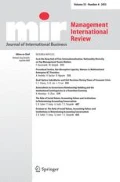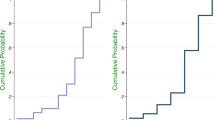Abstract
-
International Management researchers often rely on surveys to collect their data. However, responses to survey questions can be biased by response styles, a respondent’s tendency to provide a systematic response to questions regardless of their content. Response styles vary across countries and individuals, but there is limited systematic research that investigateswhy they vary.
-
Our study investigates middle (MRS) versus extreme response styles (ERS), the tendency to use the middle or extreme categories on rating scales. We examine the impact of culture, different types of scale anchors and the level of knowledge of the topic in question on MRS and ERS.
-
We asked five groups of respondents (Chinese in China, Chinese in Australia, Anglo-Australians in Australia, and two groups of German students in Germany) to indicate on a 10-point scale whether certain employee attitudes or behaviour were more typically Australian (left-hand of the scale) or Chinese (right-hand of the scale). We then asked them how they would rate the performance (low to high on a 10-point scale) of an employee who displayed this attitude or behaviour.
-
Asian respondents showed higher MRS than Western respondents. When scale anchors referred to naturally opposing and mutually exclusive constructs (Australian versus Chinese) respondents showed more ERS than when they referred to level or degree of a construct (low-high performance). Knowledge of cross national differences resulted in higher ERS on behavioural questions but not on performance questions.



Similar content being viewed by others
Notes
In retrospect we should probably have mentioned the country context in which respondents were expected to evaluate performance. However, we argue that in the absence of a country specification, respondents would have been most likely to evaluate performance in the context of their home country. This is likely to be true even for the Chinese students in Australia as researchers have found that values change slowly (see Hofstede,1980/2001 and Olivas-Luján et al.,2004).
A reviewer suggested that standard deviation might not be the most appropriate way to measure extreme response styles as—theoretically—a respondent might display a very low standard deviation if he/she picked all of his/her responses at one end of the scale. We therefore reran our analyses reported below with a recoded variable that gave a score of + 2 for 1/10 scores, + 1 for 2/9 scores, 0 for 3/8, scores, −1 for 4/7 scores and −2 for 5/6 scores. Our results were identical to our analyses based on standard deviation, both in terms of relative ranking of the five data collection groups, and in terms of statistical significances between them.
References
Allik, J., & McCrae, R. R. (2004). Toward a geography of personality traits: Patterns of profiles across 36 cultures.Journal of Cross- Cultural Psychology, 35(1), 13–28.
Baumgartner, H., & Steenkamp, J.-B. E. M. (2001). Response styles in marketing research: A cross-national investigation.Journal of Marketing Research, 38(2), 143–156.
Bello, D., Leung, K., Radebaugh, R., Tung, R. L., & van Witteloostuijn, A. (2009). From the editors: Student samples in international business research.Journal of International Business Studies, 40(3), 361–364.
Bond, M. H., & Yang, K.-S. (1982). Ethnic affirmation versus cross-cultural accommodation. The variable impact of questionnaire language on chinese bilinguals from hong kong.Journal of Cross-Cultural Psychology, 13(2), 169–185.
Brauer, M., Chambres, P., Niedenthal, P. M., & Chatard-Pannetier, A. (2004). The relationship between expertise and evaluative extremity: The moderating role of experts’ task characteristics.Journal of Personality and Social Psychology, 86(1), 5–18.
Buckley, P. J., Devinney, T. M., & Louviere, J. J. (2007). Do managers behave the way theory suggests? A choice-theoretic examination of foreign direct investment location decision-making.Journal of international business studies, 38(7), 1069–1094.
Chami-Castaldi, E., Reynolds, N., & Wallace, J. (2008). Individualised rating-scale procedure: A means of reducing response style contamination in survey data?The Electronic Journal of Business Research Methods, 6(1), 9–20.
Chen, C., Lee, S.-Y., & Stevenson, H. W. (1995). Response style and cross-cultural comparisons of rating scales among east asian and north american students.Psychological Science, 6(3), 170–175.
Cheung, G. W., & Rensvold, R. B. (2000). Assessing extreme and acquiescence response sets in cross-cultural research using structural equations modelling.Journal of Cross-Cultural Psychology, 31(2), 187–212.
Chun, K.-T., Campbell, J. B., & Yoo, J. H. (1974). Extreme response style in crosscultural research.Journal of Cross-Cultural Psychology, 5(4), 465–480.
Clarke, I (2000). Extreme response style in cross-cultural research: An empirical investigation.Journal of Social Behavior and Personality, 15(1), 137–152.
Clarke, I., III (2001). Extreme response style in cross-cultural research.International Marketing Review, 18(3), 301–324.
Couch, A., & Keniston, K. (1960). Yea-sayers and nay-sayers: Agreeing response set as a personality variable.Journal of Abnormal and Social Psychology, 60(2), 151–174.
Cronbach, L. J. (1946). Response sets and test validity.Educational and Psychological Measurement, 6, 475–494.
Dolnicar, S., & Grün, B. (2007). How constrained a response: A comparison of binary, ordinal and metric answer formats.Journal of Retailing and Consumer Services, 14(2), 108–122.
Fischer, R. (2004). Standardization to account for cross-cultural response bias: A classification of score adjustment procedures and review of research in JCCP.Journal of Cross-Cultural Psychology, 35(3), 263–282.
Gao, G., Kao, K., & Ting-Toomey, S. (1998).Communicating effectively with the Chinese. London: Sage.
Gibbons, J. L., Zellner, J. A., & Rudek, D. J. (1999). Effects of language and meaningfulness on the use of extreme response style by Spanish-English Bilinguals.Cross-Cultural Research, 33(4), 369–381.
Greenleaf, E. A. (1992). Measuring extreme response style.Public Opinion Quarterly, 56(3), 328–351.
Hall, E. T. (1976).Beyond culture. New York: Doubleday.
Hamamura, T., Heine, S. J., & Paulhus, D. L. (2008). Cultural differences in response styles:The role of dialectical thinking. Personality and Individual Differences, 44(4), 932–942.
Harzing, A. W. K. & 32 country collaborators (2005). The use of english questionnaires in cross-national research: Does cultural accommodation obscure National Differences?International Journal of Cross Cultural Management, 5(2), 213–224.
Harzing, A. W. K. (2006). Response styles in cross-national survey research: A 26-country study.International Journal of Cross Cultural Management, 6(2), 243–266.
Harzing, A. W. K. & 26 Collaborators (2009). Rating versus ranking: What is the best way to reduce response and language bias in cross-national research?International Business Review, 18(4), 417–432.
Hofstede, G. (1980).Cultures consequences. international differences in work-related values. London: Sage.
Hofstede, G. (2001).Cultures consequences, comparing values, behaviors institutions and organizations across nations, (2nd Ed.). Thousand Oaks: Sage.
House, R. J., Hanges, P. J., Javidan, M., Dorfman, P. W., & Gupta, V. (2004).culture, leadership, and organizations: The globe study of 62 societies. Thousand Oaks: Sage
Hui, C. H., & Triandis, H. C. (1989). Effects of culture and response format on extreme response style.Journal of Cross-Cultural Psychology, 20(3), 296–309.
Johnson, T. J., Kulesa, P., Cho, Y. I., & Shavitt, S. (2005). The relation between culture and response styles.Journal of Cross-Cultural Psychology, 36(2), 264–277.
Johnson, T., O’Rourke, D., Chavez, N., Sudman, S., Warnecke, R., Lacey, L., & Horm, J. (1997). Social cognition and responses to survey questions among culturally diverse populations. In L. Lyberg, P. Biemer, M. Collins, E. de Leeuw, C. Dippo, N. Schwarz, & D. Trewin (Eds.),Survey Measurement and Process Quality (pp. 87–113). New York: Wiley.
Lee, C., & Green, R. T. (1991). Cross-cultural examination of the fishbein behavioral intentions model.Journal of International Business Studies, 25(2), 289–305.
Leung, K., & Bond, M. H. (1989). On the empirical investigation of dimensions for cross-cultural comparisons.Journal of Cross-Cultural Psychology, 20(2), 133–151.
O’Donovan, D. (1965). Rating extremity: Pathology or meaningfulness?Psychol Rev, 72(1965), 802.
Olivas-Luján, M. R., Harzing, A. W. K., & McCoy, S. (2004). September 11, 2001: Two quasi-experiments on the influence of threats on cultural values and cosmopolitanism. InternationalJournal of Cross-Cultural Management, 4(2), 211–228.
Peng, K., & Nisbett, R. E. (1999). Culture, dialectics, and reasoning about contradiction.American Psychologist, 54(9),741–754.
Ross, C. E., & Mirowsky, J. (1984). Socially desirable response and acquiescence in a cross-cultural survey of mental health.Journal of Health and Social Behavior, 25(2), 189–197.
Shiomi, K., & Loo, R. (1999). Cross-cultural response styles on the Kirton adaptation–innovation inventory.Social Behavior and Personality, 27(4), 413–420.
Si, S. X., & Cullen, J. B. (1998). Response categories and potential cultural bias: Effects of an explicit middle point in cross-cultural surveys.International Journal of Organizational Analysis, 6(3), 218–230.
Smith, P. B. (2004). Acquiescent response bias as an aspect of cultural communication style.Journal of Cross-Cultural Psychology, 35(1), 50–61.
Steenkamp, J. B. E. M., & Baumgartner, H. (1998). Assessing measurement invariance in cross-national consumer research.Journal of Consumer Research, 25(June), 78–90.
Stening, B. W., & Everett, J. E. (1984). Response styles in a cross-cultural managerial study.Journal of Social Psychology, 122(2), 151–156.
Takahashi, K., Ohara, N., Antonucci, T. C., & Akiyama, H. (2002). Commonalities and differences in close relationships among the Americans and Japanese: A comparison by the individualism/collectivism concept.International Journal of Behavioral Development, 26(5), 453–465.
Trompenaars. (1997).Riding the waves of culture. Understanding cultural diversity in business. London: Nicholas Brealey Publishing.
van de Vijver, F. J. R. (2003). Bias and Substantive Analyses. In J. A. Harkness, F. J. R. van de Vijver, & P. P. Mohler (Eds.),Crosscultural Survey Methods ( pp. 207–234). Hoboken: Wiley.
van de Vijver, F. J. R., & Leung, K. (1997).Methods and data analysis for cross-cultural research. Newbury Park: Sage.
van Herk, H., Poortinga, Y. H., & Verhallen, T. M. M. (2004). Response styles in rating scales: Evidence of method bias in data from 6 eu countries.Journal of Cross-Cultural Psychology, 35(3), 346–460.
Watkins, D., & Cheung, S. (1995). Culture, gender, and response bias: An analysis of responses to the self-description questionnaire.Journal of Cross-Cultural Psychology, 26(5), 490–504.
Zax, M., & Takahashi, S. (1967). Cultural influences on response style: comparisons of Japanese and American college students.Journal of Social Psychology, 71(1), 3–10.
Acknowledgements
This research was supported under Australian Research Council’s Discovery Projects funding scheme (project DP0555977). The views expressed herein are those of the authors and are not necessarily those of the Australian Research Council. This paper was also partly supported by the Key Project by National Natural Science Foundation of China (Project No.: 70732002).
Author information
Authors and Affiliations
Corresponding author
Rights and permissions
About this article
Cite this article
Harzing, AW., Brown, M., Köster, K. et al. Response Style Differences in Cross-National Research. Manag Int Rev 52, 341–363 (2012). https://doi.org/10.1007/s11575-011-0111-2
Received:
Revised:
Accepted:
Published:
Issue Date:
DOI: https://doi.org/10.1007/s11575-011-0111-2




